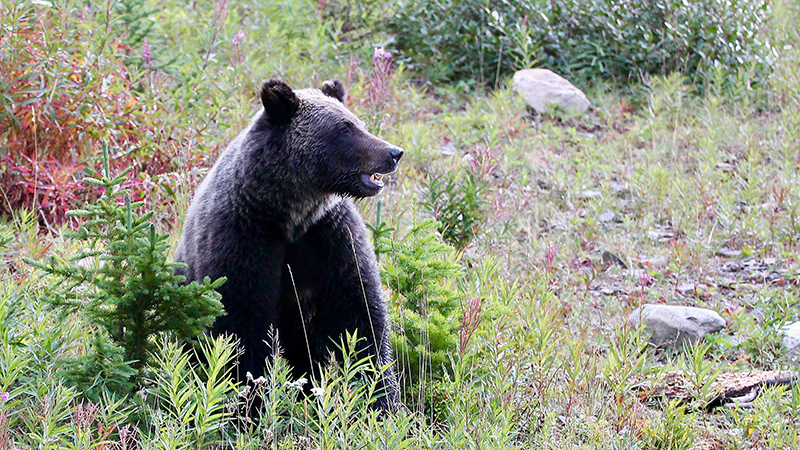
We had just spotted our third bear in as many days on a road trip along Alberta’s Icefields Parkway. As we drove around a curve on the narrow two-lane highway, he suddenly came into view, nosing around in a grassy meadow alongside the road. It was May, which in the Canadian Rockies can be a wild mix of spring and winter. One day, I wore a T-shirt and got a sunburn; the next, we got caught in a blizzard and had to hike through two feet of snow.
This was a few years ago, in a pre-pandemic world, during a family road trip from Edmonton to Calgary via Jasper, Lake Louise and Banff, with stops along the way to see glaciers, waterfalls and sapphire lakes still partially covered with ice. And while the weather was downright manic, it turned out to be a perfect time of year for wildlife viewing. Bears are coming out of hibernation, while elk, deer and bighorn sheep migrate to lower elevations for grazing.
Maybe you’ve had to postpone that bucket-list African safari until it’s safe to travel the globe again. But in the meantime, you could visit Canada’s Serengeti in the Canadian Rockies—or take your pick of several epic Canadian “safaris,” where you can view wildlife in their natural habitat. Here are just a few to add to your bucket list.
Safety First
To respectfully observe animals in the wild, keep your distance, shut your mouth and stay downwind. It’s also a good idea to be mindful of breeding season—for the sake of your safety, not their embarrassment.
Songbirds
Birds Canada recognizes 426 Canadian bird species, and more than 350 of those can be found in Toronto. The spring songbird migration, however, is a spectacle that’s sure to impress even those who don’t spend their days marking down bird sightings on a spreadsheet. The premier spot for this annual event is Point Pelee National Park in southwestern Ontario, also known as the Warbler Capital of Canada. But it can get pretty crowded with birders, so consider these other hot spots: Fundy National Park in New Brunswick (with up to 15 types of warblers during the spring migration), Gulf Islands National Park Reserve in British Columbia (for bald eagles, tufted puffins and western screech owls) and Forillon National Park in Quebec (for colonies of nesting sea birds).
Caribou
The Great Migration of wildebeest, zebra and gazelle is considered the largest animal migration in the world, from the Serengeti in Tanzania to the Masai Mara in Kenya. But Canada has its own Great Migration: Every year, thousands of caribou migrate up to 24,000 kilometres across the Great White North. About 1.2 million barren-ground caribou live in eight migratory herds, moving seasonally from the tundra to the taiga. As with an African safari, you’re best to book a trip with a local outfitter in Nunavut, the Northwest Territories or Yukon. There’s also a good chance you’ll see bears, wolves and maybe even the elusive wolverine.
Humpback Whales
I’ve been fortunate enough to see a humpback whale and her calf while in Tahiti, but you don’t have to travel to the South Pacific to see these awe-inspiring creatures. After all, Canada has three coastlines, two of which are migratory paths for humpbacks. In the Pacific, a population of humpbacks makes the trip from Hawaii to Alaska along the BC coastline (you could spot them pretty much anywhere, but good lookout points include the Pacific Rim National Park Reserve or Gulf Islands National Park Reserve). In the Atlantic, they migrate between the Caribbean and the Arctic, and you can keep a lookout in Saguenay-St. Lawrence Marine Park in Quebec or Terra Nova National Park in Newfoundland.
There’s also a good chance you’ll see bears, wolves and maybe even the elusive wolverine.
Beluga Whales
Some animals can be found in only a few remote places on the planet, like beluga whales and narwhals in the Arctic Ocean. While an Arctic expedition cruise may be out of the question during a pandemic, it’s still possible to see beluga whales in Canada. Each year, a small population migrates to the St. Lawrence estuary in Quebec—where the river meets the sea—to “summer” here. These highly social animals travel in pods and may even swim right up to your boat or kayak.
Monarch Butterflies
I won’t complain about a long plane ride ever again: Every year, monarch butterflies make a pit stop at Point Pelee National Park on their 3,000-kilometre journey to a mountainous forest in central Mexico for the winter. And considering they weigh just half a gram, that’s quite an accomplishment. There’s also a population in BC that migrates to California for the winter. But the monarch’s natural habitat is fast disappearing, so even if you miss the migration, you can see butterflies throughout the summer by planting a garden with perennial wildflowers.
Bison & Whooping Cranes
Head to Wood Buffalo National Park, which straddles northern Alberta and the Northwest Territories, and you’ll likely see bison—particularly if you’re driving along the road into Fort Smith. You could also see black bears, moose, fox, wolf, lynx and birds, including the rare and endangered whooping crane. There’s only one migratory flock of whooping cranes left in the world, and they nest here in a network of shallow wetlands before migrating 4,000 kilometres to winter in southern Texas. While the wetlands are inhospitable to humans, flight-seeing tours can be arranged, or you might just get lucky and spot one—of only 500 left in the world—soaring in the sky above.


